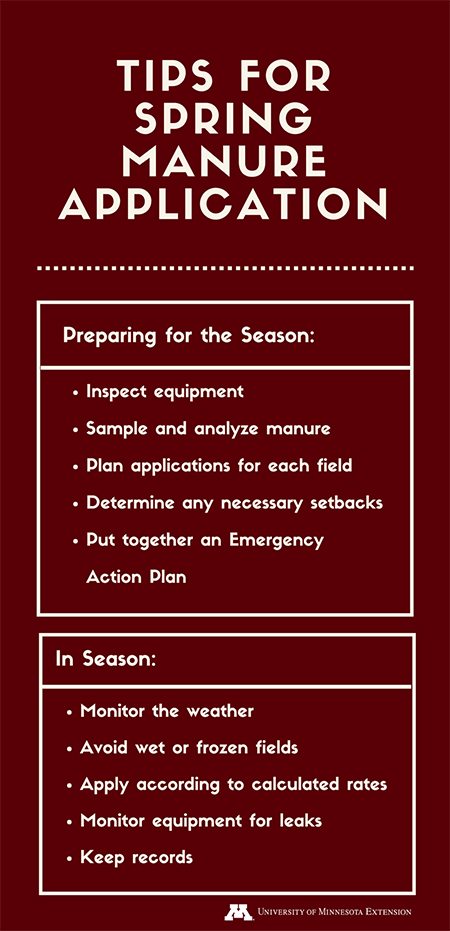
Melissa Wilson, Extension Manure Management Specialist
It may be hard to imagine spring coming anytime soon with the recent arctic temperatures, but in a few short months it’ll be time to apply nutrients for the upcoming crops. If you plan to apply manure, now is the time to start mapping out your plans for the year to save headaches down the road. Here are some tips to get you started on your plans and for applying manure this spring:
Tips to prepare for the season:
- Inspect Equipment. Make sure everything is functioning properly. To avoid leaks or spills, replace or repair anything that needs fixed.
- Get your manure sampled and analyzed, or find your most recent manure analysis. This will give you an accurate idea of how many nutrients are available to you.
- Plan applications for each field. Calculate your application rates using the nutrient needs of your upcoming crop (based on the University of Minnesota recommendations) and your manure nutrient analysis. Subtract out any nutrient credits from manure applied in the past 3 years or from legumes grown in the past year.
- Determine any setbacks needed in fields. This includes streams, ditches, lakes, tile inlets and sinkholes. Also mark locations of sensitive features to avoid.
- Put together an Emergency Action Plan. Make a list of emergency contacts in case of a leak or spill and think of ways that you could possibly contain a spill so that you can have the appropriate tools on hand.
Tips for manure application:
- Monitor the weather. Avoid applying immediately before a predicted rainfall.
- Avoid wet or frozen fields. Manure can very easily run off of a frozen field, especially in spring rains. On fields that are wet, adding manure (which has liquid in it) will only increase the likelihood of runoff or the start of tile flow. You are also more likely to cause soil compaction in wet conditions.
- Apply manure according to calculated rates. Do not overapply! Nutrients are less likely to be lost to our waterways when applied at appropriate rates.
- Monitor equipment for leaks. Have equipment handy for stopping leaks and for cleanup. Know the numbers you need to call if there is a spill.
- Keep records. Always note the field location, manure source and amount applied. Keep records on file for at least 3 years.
For the latest nutrient management information, like UMN Extension Nutrient Management on Facebook, follow us on Twitter or visit our website.
Source: University of Minnesota Extension



Leave A Comment